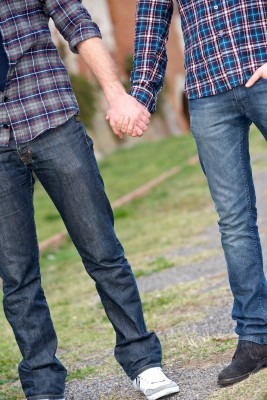5 Myths About Homosexuality Debunked By Science
September 28, 2012 by Justin Lehmiller
There are countless myths and stereotypes about gays and lesbians spanning everything from their mannerisms to their sex lives to the nature of their relationships. In this article, I will review five of the most common myths and evaluate them in light of what scientific research has to say.
MYTH #1: Gay men sleep around a lot more than straight men. Although some politicians and anti-gay groups want you to believe that gay men are a bunch of “horny sluts,” there is good reason not to buy into this stereotype. First, although gay men typically report a higher number of partners than heterosexual men on average, we need to look at the median (or 50th percentile) before drawing any conclusions because averages can be easily distorted by a few extreme responses (and, indeed, there is a small number of gay men who accumulate an extremely large number of partners). For instance, if we look at the median number of sex partners in the National Health and Social Life Survey (a nationally representative sex survey conducted in the United States), we see that gay men only outpace heterosexual men by one [1]. Other studies have reported similar findings. Thus, the majority of gay and heterosexual men are actually pretty similar in this regard.
Second, it is important to note that gay men are no hornier than their heterosexual counterparts. Research has found that the sex drives of gay and heterosexual men are equally high [2]. This tells us that any difference in number of partners is not due to gay men having increased sexual urges; rather, it is probably a reflection of the fact that men are generally more interested in casual sex than are women. Thus, heterosexual men may lag behind slightly because they do not have as many opportunities—not because they are any less interested in sex.
MYTH #2: Gay parents raise gay children. There is absolutely no scientific support for the idea that homosexuality is socially learned or that children are “seduced” into the gay community. A review of several scientific studies reveals that children raised by gay parents do not have an increased likelihood of being gay compared to children whose parents are heterosexual [3]. Think about it this way—if homosexuality is learned, then heterosexuality must also be learned. If that’s the case, why are most gay and lesbian people a product of heterosexual parenting?
MYTH #3: Gay men are inherently feminine and lesbians are inherently masculine. I do not dispute the idea that some gay men are effeminate and some lesbians are “butch,” but it is important to recognize that not everyone in the gay community displays gender role nonconformity. Also, keep in mind that there are plenty of heterosexual people who do not conform to gender roles. If sexual orientation was so easy to identify based upon deviations from gender-typical behavior, everyone would have perfect “gaydar,” but the reality is that they do not [4].
MYTH #4: Most child molesters are gay men. Not. True. At. All. In fact, there is nothing that even begins to back up this idea, especially in light of the fact that crime statistics reveal that the vast majority of people who molest children are male and the vast majority of their victims are female. This tells us that there are far more heterosexual child molesters in the world than anything. On a side note, psychological research has demonstrated that gay men show no more sexual arousal in response to images of male children than heterosexual men show in response to images of female children [5]. This tells us that sexual attraction to children is an entirely separate issue from sexual orientation and that we should not be conflating sexual identities with sex crimes.
MYTH #5: Gay couples assign one partner to be the “husband” one partner to be the “wife.” Although popular movies such as The Birdcage tend to depict gay couples as consisting of someone who plays the role of a traditional husband and someone who plays the role of a traditional wife, the fact of the matter is that gay and lesbian couples are less likely to adopt these strict roles than their heterosexual counterparts. In fact, gay couples tend to share power and responsibilities equally [6].
Want to learn more about The Psychology of Human Sexuality? Click here for a complete list of articles or like the Facebook page to get articles delivered to your newsfeed.
[1] Laumann, E. O., Gagnon, J., Michael, R., & Michaels, S. (1994). The social organization of sexuality: Sexual practices in the United States. Chicago: University of Chicago Press.
[2] Lippa, R. A. (2006). Is high sex drive associated with increased sexual attraction to both sexes? Psychological Science, 17, 46-52.
[3] Fitzgerald, B. (1999). Children of lesbian and gay parents: A review of the literature. Marriage and Family Review, 29, 57-75.
[4] Rieger, G., Linsenmeier, J. A. W., Gygax, L., Garcia, S., & Bailey, J. M. (2010). Dissecting “gaydar”: Accuracy and the role of masculinity-feminity. Archives of Sexual Behavior, 39, 124-140.
[5] Freund, K., Watson, R., & Rienzo, D. (1989). Heterosexuality, homosexuality, and erotic age preference. Journal of Sex Research, 26, 107-117.
[6] Kurdek, L. A. (1998). Relationship outcomes and their predictors: Longitudinal evidence from heterosexual married, gay cohabiting, and lesbian cohabiting couples. Journal of Marriage and Family, 60, 553-568.
Image Source: 123rf.com
You Might Also Like:

Dr. Justin Lehmiller
Founder & Owner of Sex and PsychologyDr. Justin Lehmiller is a social psychologist and Research Fellow at The Kinsey Institute. He runs the Sex and Psychology blog and podcast and is author of the popular book Tell Me What You Want. Dr. Lehmiller is an award-winning educator, and a prolific researcher who has published more than 50 academic works.
Read full bio >


